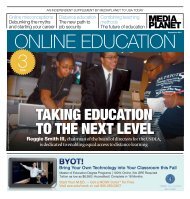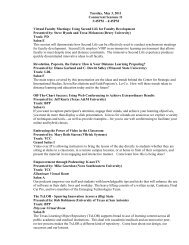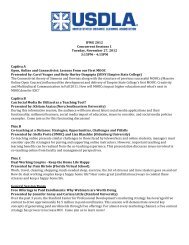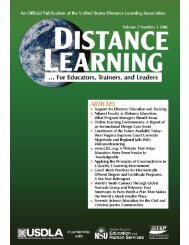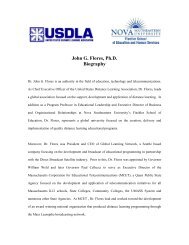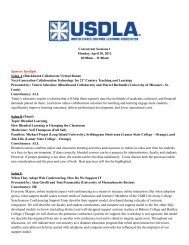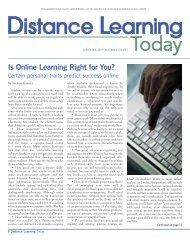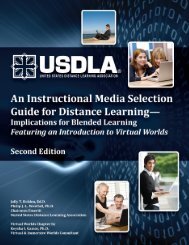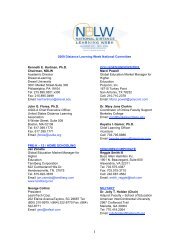United States Distance Learning Association
United States Distance Learning Association
United States Distance Learning Association
- No tags were found...
Create successful ePaper yourself
Turn your PDF publications into a flip-book with our unique Google optimized e-Paper software.
lab assistant’s room beside the classroom<br />
and can see the students<br />
through a window.<br />
Before the face-to-face session, instructional<br />
materials and Live Classroom procedures<br />
were uploaded in the WebCT course<br />
for the students (see Appendix A). Procedural<br />
checklists were distributed to the faculty<br />
(see Appendix B). CLTT Developers<br />
and technical help were available to be<br />
with the students and the instructor for<br />
these face-to-face sessions.<br />
Both instructors ran two face-to-face<br />
sessions. Following that, the senior faculty<br />
member felt competent to run her class virtually<br />
off-site. The other faculty member<br />
continued to meet with her class face-toface<br />
and used Live Classroom to bring in<br />
the foreign student.<br />
It was hoped that these two faculty<br />
members could be influential in the diffusion<br />
process for this technology. They did a<br />
presentation of their experiences in a luncheon<br />
forum for 40 faculty and continue to<br />
use the platform themselves. In addition,<br />
CLTT delivers a 6-week online training session<br />
for faculty who are going to teach<br />
fully online and Live Classroom is incorporated<br />
into this course. Over 50 faculty have<br />
completed the course over the past year.<br />
Despite the presentation and the online<br />
training, only five faculty members have<br />
adopted Live Classroom over the course of<br />
the year. Three of the faculty use it for fully<br />
online courses and two faculty members<br />
use it for recording and archiving their<br />
face-to-face sessions. A more systematic<br />
approach using diffusion theory may have<br />
contributed to a faster rate of adoption<br />
among faculty at the university.<br />
an innovation, communication channels,<br />
time, and a social system.<br />
INNOVATION<br />
According to Rogers (1995) the rate of<br />
adoption of an innovation is based upon<br />
the perceived characteristics of the innovation.<br />
In other words, the innovation could<br />
be beneficial, but if it is not perceived as<br />
such, will not be adopted. These characteristics<br />
are categorized as relative advantage,<br />
compatibility, complexity, trialability, and<br />
observability.<br />
RELATIVE ADVANTAGE<br />
For the two faculty members in this<br />
pilot, the relative advantage of using this<br />
technology was to connect an international<br />
student to their face-to-face group. The<br />
senior faculty member realized that this<br />
would also benefit her students as they<br />
were working full-time jobs and they<br />
would appreciate not having to come onsite<br />
to classes. She was receptive to the idea<br />
of having regularly scheduled virtual<br />
evening classes.<br />
The junior faculty member was not<br />
ready to take that step and she felt more<br />
comfortable in the face-to-face environment.<br />
She said “This was my first time<br />
teaching a graduate class and I did not<br />
want to abandon my students.” She felt<br />
that there was a disadvantage to her students<br />
in doing these virtual sessions. Interestingly<br />
she did move to a fully online<br />
environment the next semester. This might<br />
be the result of her own comfort level and<br />
her realization that she could still interact<br />
with her students and was not in any way<br />
abandoning them.<br />
DIFFUSION THEORY<br />
Rogers (1976) defines diffusion as “the process<br />
in which an innovation is communicated<br />
through certain channels over time<br />
among members of a social system” (p. 5).<br />
The concept contains four main elements:<br />
COMPATIBILITY<br />
Rogers (1995) defines compatibility as<br />
the perception of the innovation in relation<br />
to existing values, experiences, and needs<br />
of the potential adopters. In the case of the<br />
junior faculty member, she recalled her<br />
50 <strong>Distance</strong> <strong>Learning</strong> Volume 4, Issue 4



